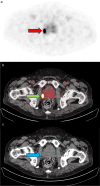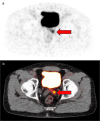The accuracy and intra- and interobserver variability of PSMA PET/CT for the local staging of primary prostate cancer
- PMID: 38273003
- PMCID: PMC11043118
- DOI: 10.1007/s00259-024-06594-0
The accuracy and intra- and interobserver variability of PSMA PET/CT for the local staging of primary prostate cancer
Abstract
Purpose: Prostate-specific membrane antigen (PSMA) positron emission tomography/ computed tomography (PET/CT) is recognized as the most accurate imaging modality for detection of metastatic high-risk prostate cancer (PCa). Its role in the local staging of disease is yet unclear. We assessed the intra- and interobserver variability, as well as the diagnostic accuracy of the PSMA PET/CT based molecular imaging local tumour stage (miT-stage) for the local tumour stage assessment in a large, multicentre cohort of patients with intermediate and high-risk primary PCa, with the radical prostatectomy specimen (pT-stage) serving as the reference standard.
Methods: A total of 600 patients who underwent staging PSMA PET/CT before robot-assisted radical prostatectomy was studied. In 579 PSMA positive primary prostate tumours a comparison was made between miT-stage as assessed by four nuclear physicians and the pT-stage according to ISUP protocol. Sensitivity, specificity and diagnostic accuracy were determined. In a representative subset of 100 patients, the intra-and interobserver variability were assessed using Kappa-estimates.
Results: The sensitivity and specificity of the PSMA PET/CT based miT-stage were 58% and 59% for pT3a-stage, 30% and 97% for ≥ pT3b-stage, and 68% and 61% for overall ≥ pT3-stage, respectively. No statistically significant differences in diagnostic accuracy were found between tracers. We found a substantial intra-observer agreement for PSMA PET/CT assessment of ≥ T3-stage (k 0.70) and ≥ T3b-stage (k 0.75), whereas the interobserver agreement for the assessment of ≥ T3-stage (k 0.47) and ≥ T3b-stage (k 0.41) were moderate.
Conclusion: In a large, multicentre study evaluating 600 patients with newly diagnosed intermediate and high-risk PCa, we showed that PSMA PET/CT may have a value in local tumour staging when pathological tumour stage in the radical prostatectomy specimen was used as the reference standard. The intra-observer and interobserver variability of assessment of tumour extent on PSMA PET/CT was moderate to substantial.
Keywords: Neoplasm Staging; Observer Variation; Positron Emission Tomography Computed Tomography; Prostatic Neoplasms.
© 2024. The Author(s).
Conflict of interest statement
The authors have no relevant financial or non-financial interests to disclose.
Figures


Similar articles
-
How accurate is 68Gallium-prostate specific membrane antigen positron emission tomography / computed tomography (68Ga-PSMA PET/CT) on primary lymph node staging before radical prostatectomy in intermediate and high risk prostate cancer? A study of patient- and lymph node- based analyses.Urol Oncol. 2022 Jan;40(1):6.e1-6.e9. doi: 10.1016/j.urolonc.2021.07.006. Epub 2021 Aug 13. Urol Oncol. 2022. PMID: 34400066
-
The Added Value of Prostate-specific Membrane Antigen Positron Emission Tomography/Computed Tomography to Magnetic Resonance Imaging for Local Staging of Prostate Cancer in Patients Undergoing Radical Prostatectomy.Eur Urol Oncol. 2025 Jun;8(3):731-738. doi: 10.1016/j.euo.2024.11.002. Epub 2024 Nov 29. Eur Urol Oncol. 2025. PMID: 39613565
-
A prospective randomized multicentre study of the impact of gallium-68 prostate-specific membrane antigen (PSMA) PET/CT imaging for staging high-risk prostate cancer prior to curative-intent surgery or radiotherapy (proPSMA study): clinical trial protocol.BJU Int. 2018 Nov;122(5):783-793. doi: 10.1111/bju.14374. Epub 2018 Jun 3. BJU Int. 2018. PMID: 29726071 Clinical Trial.
-
68Ga-Labeled Prostate-specific Membrane Antigen Ligand Positron Emission Tomography/Computed Tomography for Prostate Cancer: A Systematic Review and Meta-analysis.Eur Urol Focus. 2018 Sep;4(5):686-693. doi: 10.1016/j.euf.2016.11.002. Epub 2016 Nov 15. Eur Urol Focus. 2018. PMID: 28753806
-
Impact of intraprostatic PSMA maximum standardised uptake value following prostatectomy: a systematic review and meta-analysis.BJU Int. 2025 May;135(5):720-732. doi: 10.1111/bju.16608. Epub 2025 Jan 7. BJU Int. 2025. PMID: 39763428
Cited by
-
Prognostic value of PSMA PET/CT-Based local staging in predicting biochemical recurrence after radical prostatectomy.Eur J Nucl Med Mol Imaging. 2025 Jul 28. doi: 10.1007/s00259-025-07455-0. Online ahead of print. Eur J Nucl Med Mol Imaging. 2025. PMID: 40717186 No abstract available.
-
Evaluating the Added Value of Concurrent Contrast-enhanced Diagnostic CT for PSMA-PET/CT Interpretation.Acad Radiol. 2025 Jan;32(1):275-286. doi: 10.1016/j.acra.2024.08.008. Epub 2024 Aug 14. Acad Radiol. 2025. PMID: 39147641
-
The intra- and interobserver variability of PSMA-expression scores in patients with primary prostate cancer.EJNMMI Res. 2024 Oct 24;14(1):99. doi: 10.1186/s13550-024-01152-z. EJNMMI Res. 2024. PMID: 39446290 Free PMC article. No abstract available.
-
Semi-standardized evaluation of extraprostatic extension and seminal vesicle invasion with [18F]PSMA-1007 PET/CT: a comparison to MRI using histopathology as reference.EJNMMI Rep. 2025 Jan 3;9(1):1. doi: 10.1186/s41824-024-00234-4. EJNMMI Rep. 2025. PMID: 39747706 Free PMC article.
-
Biopsy-free radical prostatectomy for prostate cancer-modern reality or pipe dream?Transl Androl Urol. 2025 May 30;14(5):1165-1168. doi: 10.21037/tau-2025-8. Epub 2025 May 27. Transl Androl Urol. 2025. PMID: 40529023 Free PMC article. No abstract available.
References
-
- Brierly J. TNM classification of malignant tumours, 8th edition: Wiley-Blackwell; 2017.
-
- Soeterik TFW, van Melick HHE, Dijksman LM, Biesma DH, Witjes JA, van Basten JA. Multiparametric Magnetic Resonance Imaging Should Be Preferred Over Digital Rectal Examination for Prostate Cancer Local Staging and Disease Risk Classification. Urology. 2021;147:205–212. doi: 10.1016/j.urology.2020.08.089. - DOI - PubMed
-
- Hofman MS, Lawrentschuk N, Francis RJ, Tang C, Vela I, Thomas P, et al. Prostate-specific membrane antigen PET-CT in patients with high-risk prostate cancer before curative-intent surgery or radiotherapy (proPSMA): a prospective, randomised, multicentre study. The Lancet. 2020;395:1208–1216. doi: 10.1016/s0140-6736(20)30314-7. - DOI - PubMed
Publication types
MeSH terms
Substances
LinkOut - more resources
Full Text Sources
Medical
Miscellaneous

